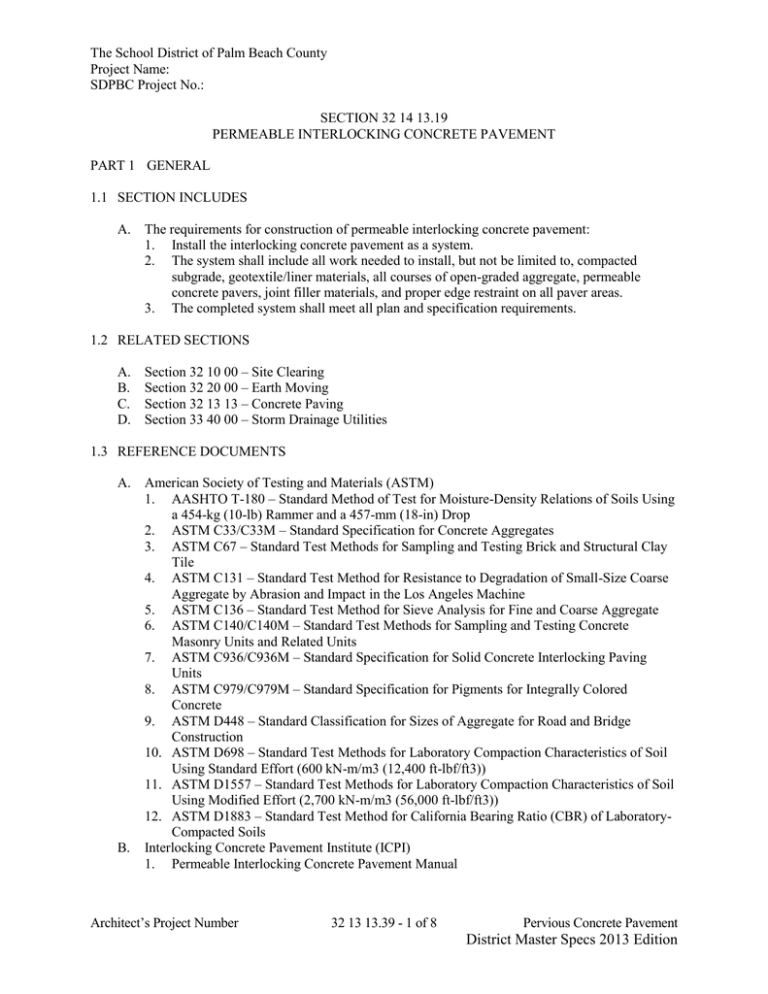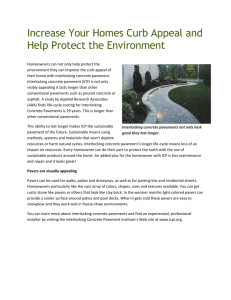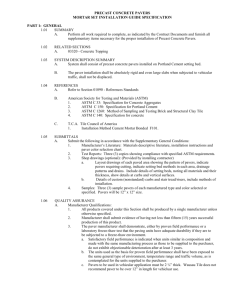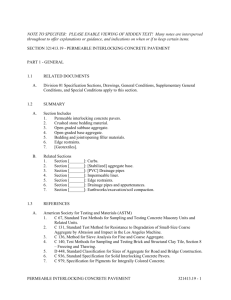section 02811 (32 80 10) - the School District of Palm Beach County
advertisement

The School District of Palm Beach County Project Name: SDPBC Project No.: SECTION 32 14 13.19 PERMEABLE INTERLOCKING CONCRETE PAVEMENT PART 1 GENERAL 1.1 SECTION INCLUDES A. The requirements for construction of permeable interlocking concrete pavement: 1. Install the interlocking concrete pavement as a system. 2. The system shall include all work needed to install, but not be limited to, compacted subgrade, geotextile/liner materials, all courses of open-graded aggregate, permeable concrete pavers, joint filler materials, and proper edge restraint on all paver areas. 3. The completed system shall meet all plan and specification requirements. 1.2 RELATED SECTIONS A. B. C. D. Section 32 10 00 – Site Clearing Section 32 20 00 – Earth Moving Section 32 13 13 – Concrete Paving Section 33 40 00 – Storm Drainage Utilities 1.3 REFERENCE DOCUMENTS A. American Society of Testing and Materials (ASTM) 1. AASHTO T-180 – Standard Method of Test for Moisture-Density Relations of Soils Using a 454-kg (10-lb) Rammer and a 457-mm (18-in) Drop 2. ASTM C33/C33M – Standard Specification for Concrete Aggregates 3. ASTM C67 – Standard Test Methods for Sampling and Testing Brick and Structural Clay Tile 4. ASTM C131 – Standard Test Method for Resistance to Degradation of Small-Size Coarse Aggregate by Abrasion and Impact in the Los Angeles Machine 5. ASTM C136 – Standard Test Method for Sieve Analysis for Fine and Coarse Aggregate 6. ASTM C140/C140M – Standard Test Methods for Sampling and Testing Concrete Masonry Units and Related Units 7. ASTM C936/C936M – Standard Specification for Solid Concrete Interlocking Paving Units 8. ASTM C979/C979M – Standard Specification for Pigments for Integrally Colored Concrete 9. ASTM D448 – Standard Classification for Sizes of Aggregate for Road and Bridge Construction 10. ASTM D698 – Standard Test Methods for Laboratory Compaction Characteristics of Soil Using Standard Effort (600 kN-m/m3 (12,400 ft-lbf/ft3)) 11. ASTM D1557 – Standard Test Methods for Laboratory Compaction Characteristics of Soil Using Modified Effort (2,700 kN-m/m3 (56,000 ft-lbf/ft3)) 12. ASTM D1883 – Standard Test Method for California Bearing Ratio (CBR) of LaboratoryCompacted Soils B. Interlocking Concrete Pavement Institute (ICPI) 1. Permeable Interlocking Concrete Pavement Manual Architect’s Project Number 32 13 13.39 - 1 of 8 Pervious Concrete Pavement District Master Specs 2013 Edition The School District of Palm Beach County Project Name: SDPBC Project No.: 1.4 SUBMITTALS A. Manufacturer’s drawings and details 1. Indicate perimeter conditions, relationship to adjoining materials and assemblies, expansion and control joints (if needed), concrete paver layout, concrete paver patterns (if needed), concrete paver color arrangement (if needed), and concrete paver installation and setting details. 2. Indicate layout, pattern, and relationship of paving joints to fixtures and project formed details. 3. A copy of the ACI Certification for the pavers shall be provided. B. Sieve analysis per ASTM C136 for upper and lower sub-base and bedding aggregate materials. C. Permeable Concrete Pavers: 1. Four representative full-size samples of each paver type, thickness, color, and finish that indicate the range of color variation and texture expected in the finished installation, color(s) selected by the Owner from manufacturer’s available colors. 2. Accepted samples become the standard of acceptance for the work. 3. Test results from an independent testing laboratory certifying compliance of concrete pavers with ASTM C936/C936M. 4. Manufacturer’s material safety data sheets for the safe handling of the specified materials and products. D. The Contractor or Sub-contractor responsible for installation of the paving system shall demonstrate the following previous experience: 1. A copy of their current certificate from the Interlocking Concrete Pavement Institute Concrete Paver Installer Certification program. 2. Job references from at least two projects of a similar size and complexity. a. Provide Owner/Architect/Engineer/General Contractor names, postal address, phone, fax, and email address and dates of construction. 1.5 QUALITY ASSURANCE A. The Contractor or Sub-contractor responsible for installation of the paving system shall provide: 1. A written method statement and quality control plan that describes material staging and flow, paving direction and installation procedures, including representative reporting forms that ensure conformance to the project specifications. B. Schedule a preconstruction meeting with the District Senior Project Administrator or designated attendee. C. A mock up pavement area shall be installed as shown on the plans. 1. Install a 3 m x 3 m [10 ft x 10 ft] area with base, bedding, and pavers. 2. Use this area to determine surcharge of the bedding layer, joint sizes, lines, laying pattern(s), color(s), and texture of the job. 3. This area will be used as the standard by which the work will be judged. 4. Subject to acceptance by owner, mock-up may be retained as part of finished work. 5. If mock-up is not retained, remove and properly dispose of mock-up 1.6 DELIVERY, STORAGE AND HANDLING A. Deliver materials in manufacturer’s original, unopened, undamaged packaging with identification labels intact. Architect’s Project Number 32 13 13.39 - 2 of 8 Pervious Concrete Pavement District Master Specs 2013 Edition The School District of Palm Beach County Project Name: SDPBC Project No.: 1. B. Coordinate delivery and paving schedule to minimize interference with normal use of buildings adjacent to paving. 2. Deliver concrete pavers to the site in steel banded, plastic banded or plastic wrapped packaging capable of transfer by forklift or clamp lift. 3. Unload pavers at job site in such a manner that no damage occurs to the product or existing construction. Store materials in a protected area such that they are kept free from mud, dirt and other foreign materials. 1.7 WARRANTY A. Provide a one-year warranty for all permeable interlocking concrete paver systems. 1. The warranty shall commence at the date of beneficial use by the District. 2. The Contractor shall provide a letter, which identifies the warranty period. B. Any defective materials shall be removed and replaced without additional cost to the District. 1. The District reserves the sole right to identify defects and request suitable corrections. 1.8 MAINTENANCE MATERIALS A. Provide additional material (pavers) for use by District for maintenance and repair. 1. The additional material shall be sufficient to cover 10% of the entire project area. 2. The additional material shall be delivered to a storage site identified by the District. B. Additional pavers shall be from the same production run as installed materials. 1.9 LEED COMPLIANCE A. The District has determined that projects shall be constructed to comply with Leadership in Energy and Environmental Design (LEED) requirements as promulgated in the document titled: LEED Reference Guide for Green Building Design and Construction, For the Design, Construction and Major Renovations of Commercial and Institutional Buildings, Including Core & Shell and K-12 School Projects, 2009 Edition. B. The District goal is LEED Silver Certification for all major projects; certification is not required for small projects consisting only of pavement construction. C. Potential LEED compliance areas shall be investigated as listed below for construction in accordance with this specification. Other areas shall be investigated as determined by the Design Professional. 1. MR Credit 5 – Regional Materials PART 2 PRODUCTS 2.1 INTERLOCKING CONCRETE PAVERS A. Meet the following physical requirements set forth in ASTM C936/C936M Standard Specification for Solid Concrete Interlocking Paving Units: 1. The average compressive strength of three pavers to be greater than 8,000 psi with no individual unit below 7,200 psi when tested in accordance with ASTM C140/C140M. 2. The average absorption of three pavers to be less than 5% with no individual unit greater than 7% when tested in accordance with ASTM C140/C140M. Architect’s Project Number 32 13 13.39 - 3 of 8 Pervious Concrete Pavement District Master Specs 2013 Edition The School District of Palm Beach County Project Name: SDPBC Project No.: 3. 4. Maximum 1.0 % weight loss of five specimens subjected to 50 freeze-thaw cycles when tested in accordance with ASTM C67. Aquaflow® pavers, as manufactured by the Hanson Heidelberg Cement Group shall set the performance standard for pavers provided under this section. 2.2 CRUSHED STONE BEDDING AND BASE MATERIALS A. Provide crushed stone with 90% fractured faces, LA Abrasion < 40 per ASTM C131, minimum CBR of 80% per ASTM D1883. B. Rounded river gravel will not be acceptable. Bedding and base materials must be crushed aggregate. C. All crushed aggregate materials shall be washed with less than 1% passing No. 200 sieve. 1. Wash water shall be from a suitable source and shall be free of impurities that might alter the color of the native materials or cause odors when the installed material is re-wetted. D. Joint or opening filler, bedding, lower and upper base shall each conform to the ASTM D448 gradation as shown in Table 1 below: Sieve Size 3 in. (75 mm) 2-1/2 in. (63 mm) 2 in. (50 mm) 1-1/2 in. (37.5 mm) 1 in. (25 mm) ¾ in. (19 mm) ½ in. (12.5 mm) 3/8 in (9.5 mm) No. 4 (4.75 mm) No. 8 (2.36 mm) No. 16 (1.16 mm) E. TABLE 1 Grading Requirements for Crushed Stone Materials Bedding Material Upper Base Material Lower Base Material ASTM No. 8 ASTM No. 57 ASTM No. 4 Percent Passing Percent Passing Percent Passing 100 90 to 100 35 to 70 100 0 to 15 95 to 100 100 0 to 5 85 to 100 25 to 60 10 to 30 0 to 10 0 to 10 0 to 5 0 to 5 Gradation criteria for the bedding stone related to the base stone shall be: 1. D15 base stone / D50 bedding stone < 5. 2. D 50 base stone / D50 bedding stone > 2. 2.3 ACCESSORIES A. Provide edge restraints as specified on the plans OR as shown on Exhibit 1. B. Plan details shall take precedence over the exhibit in this specification, as shown on exhibit 1 at the end of this specification. C. Provide geotextile fabric and impermeable liners as specified on the plans, as shown on exhibit 1 at the end of this specification. PART 3 EXECUTION Architect’s Project Number 32 13 13.39 - 4 of 8 Pervious Concrete Pavement District Master Specs 2013 Edition The School District of Palm Beach County Project Name: SDPBC Project No.: 3.1 SITE ACCESS A. Maintain site access for related educational and construction functions at all times. 3.2 SUBGRADE A. Top six inches of the subgrade shall be composed of gravel, sand, or a combination thereof. B. The subgrade shall be tested for rate of permeability by double ring infiltrometer, or other suitable test of subgrade soil permeability. 1. The tested permeability must reasonably compare to the design permeability. 2. The compacted soil permeability shall be no less than 1 inch per hour. C. The subgrade shall be compacted by a mechanical vibratory compactor to a maximum density of 92% of a maximum dry density as established by ASTM D1557 or AASHTO T 180. 1. Subgrade stabilization shall not be permitted. D. The subgrade shall be in a moist condition (within +3% of the optimum moisture content as determined by the compaction test method of ASTM D1557 or AASHTO T 180). E. The subgrade surface shall not slope at a grade in excess of 0.3%. F. The subgrade surface shall be at least two feet about the seasonal high water table elevation. 3.3 EMBANKMENT A. If fill material (embankment) is required to bring the subgrade to final elevation, it shall be clean and free of deleterious materials. 1. Placed in 8-inch maximum layers, and compacted by a mechanical vibratory compactor to a maximum density of 92% of a maximum dry density as established by ASTM D1557 or AASHTO T 180. B. Embankment permeability shall be no less than 1 inch per hour. 3.4 GEOTEXTILES A. Place on bottom and sides of the excavated area. Secure in place to prevent wrinkling from vehicle tires and tracks. B. Overlap a minimum of [300 mm (12”)] [600 mm (24”)] in the direction of drainage for all geotextile layers (over subgrade and over upper base course. C. Allow enough geotextile to exceed the final elevation of the Aquaflow paver surface. Excess geotextile should be cut flush with the finished surface after final compaction. 3.5 OPEN GRADED UPPER AND LOWER BASE A. Moisten, spread, and compact the No.2 lower base in 100 to 150 mm (4 to 6”) lifts without wrinkling or folding geotextile. 1. Place lower base to protect geotextile from wrinkling under equipment tires. 2. Track vehicles should not be used to spread the initial lower base course (lift). B. For each lift, make at least two passes in the vibratory mode then at least two in the static mode with a minimum 10 T (10 t) vibratory roller until there is no visible movement of the No. 2 stone. 1. Do not crush aggregate with the roller. C. The surface tolerance of the compacted No. 2 sub-base shall be +/- 65 mm (2 ½”) over a 3 m (10 ft) straight edge. Architect’s Project Number 32 13 13.39 - 5 of 8 Pervious Concrete Pavement District Master Specs 2013 Edition The School District of Palm Beach County Project Name: SDPBC Project No.: D. Moisten, spread and compact No. 57 upper base in 100 mm (4”) lift over the compacted lower base with a minimum 10 T (10 t) vibratory roller until there is no visible movement of the No. 57 stone. 1. Do not crush aggregate with the roller. E. The surface tolerance of the compacted No. 57 upper sub-base should not deviate more than +/13 mm (1/2”) over a 3 m (10 ft) straightedge. F. Place geotextile over the upper base layer per Part 3.4, above. 3.6 BEDDING LAYER A. Moisten, spread, and lightly compact the No. 8 bedding material using a plate compactor. 1. No visible movement should occur in base material when compaction is complete B. Loose screed the bedding course. C. Fill voids left by removed screed rails with No. 8 stone. D. The surface tolerance of the screeded No. 8 bedding layer shall be +/- 10 mm (3/8”) over a 3 m (10 ft) straightedge. E. Do not subject screeded bedding material to any pedestrian or vehicular traffic before unitpaving installation begins. 3.7 PERMEABLE INTERLOCKING CONCRETE PAVERS AND JOINT/OPENING FILL MATERIAL A. Lay the permeable concrete pavers in the pattern(s) shown on the drawings maintain straight pattern lines. B. Fill gaps at the edges of the paved area with cut pavers, ensuring no cut unit is smaller than one third of its original size. C. Cut pavers to be placed along the edge with masonry saw. 1. Use of guillotine or paver splitters is not acceptable. 2. Do not allow slurry from the cuts to adhere to the surface of the pavers. D. Fill the openings and joints with 2-4mm, washed, granite joint screenings. E. Remove excess aggregate on the surface by sweeping pavers clean. F. Compact and seat the pavers into the bedding material using a low amplitude plate compactor capable of at least 23 kN (5200 lbf) compaction at a frequency of 75-90 hz. 1. This will require at least two passes with the plate compactor. 2. Remove and replace any damaged pavers after the first pass with the plate compactor. G. Do not compact within 2 m (6 ft) of the unrestrained edges of the paving units. H. Apply additional aggregate to the openings and joints, filling them completely. 1. Remove excess aggregate by sweeping then compact the pavers. 2. This will require at least two more passes with the plate compactor. I. All pavers within 2 m (6 ft) of the laying face must be left fully compacted at the completion of each day. J. The final surface tolerance of compacted pavers shall not deviate more than +/- 10 mm (3/8”) under a 3 m (10 ft) long straightedge. K. The surface elevation of pavers shall be 3 to 6 mm (1/8 to ¼”) above adjacent drainage inlets, concrete collars, or channels to allow for future settlement. 3.8 FIELD QUALITY REQUIREMENTS A. After sweeping the surface clean, check final elevations for conformance to the drawings. B. No greater than 3 mm (1/8”) difference in height is allowed between adjacent pavers. Architect’s Project Number 32 13 13.39 - 6 of 8 Pervious Concrete Pavement District Master Specs 2013 Edition The School District of Palm Beach County Project Name: SDPBC Project No.: C. Reset or re-compact pavers until height difference is acceptable. 3.9 PROTECTION A. After work in this section is complete, the General Contractor shall be responsible for protecting work from sediment deposition and damage due to subsequent construction activity on site. END OF SECTION Architect’s Project Number 32 13 13.39 - 7 of 8 Pervious Concrete Pavement District Master Specs 2013 Edition The School District of Palm Beach County Project Name: SDPBC Project No.: EXHIBIT 1 Architect’s Project Number 32 13 13.39 - 8 of 8 Pervious Concrete Pavement District Master Specs 2013 Edition






